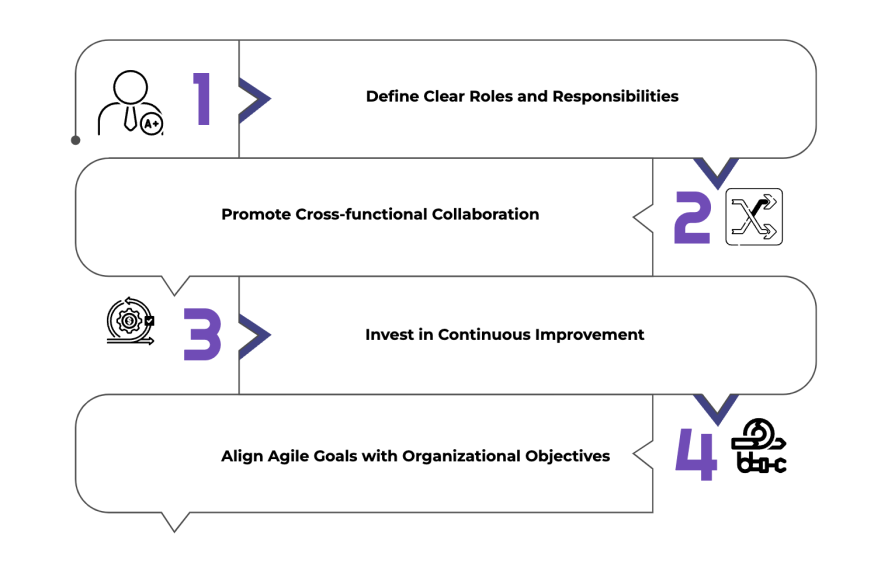As agile continues to shape the way products are developed, many product managers are now faced with the challenge of scaling these practices beyond a few teams. Agile is renowned for its flexibility, customer-centric focus, and speed, but applying it to large, multi-team environments can be complex. The key question is: how do you maintain agile’s core principles, collaboration, adaptability, and efficiency, when managing large teams across various functions, locations, or even continents?

This article covers practical ways to scale agile, going into depth on well-known frameworks like SAFe and LeSS, alongside other valuable methodologies like Scrum of Scrums (SoS), the Spotify model, Nexus, and Disciplined Agile Delivery (DAD). Keep reading to also learn about the tools that support these frameworks, such as Tuleap and Atlassian’s suite.
Scaled agile is an approach that allows you to extend agile principles across multiple teams, projects, or business units. When agile is scaled, it involves more than just increasing the team count; it means aligning each team’s efforts to ensure they work harmoniously toward your company’s strategic goals. Scaled agile frameworks provide structures that improve coordination, governance, and communication across teams.
There’s no single solution for scaling agile, but the following frameworks offer a variety of structures, philosophies, and practices to help you tailor agile to your unique needs:
Each framework is designed to solve specific scaling needs. For example, SAFe may suit highly regulated environments that require a clear governance structure, while the Spotify model emphasizes autonomy and suits innovation-focused organizations. Nexus and SoS both extend scrum, making them great for companies already familiar with scrum principles.
Scaling agile effectively requires careful planning and commitment to maintaining agile’s core values. Here are some practical steps to guide the process:

To better understand how you can effectively implement scaled agile, pay attention to the following examples of successful organizations:
Using agile principles to guide its content creation process, Netflix relies on rapid feedback loops and data-driven decisions. This agile approach has led to a higher success rate for Netflix Originals, allowing the company to quickly adjust content based on audience preferences.
The defense company SAAB used agile methodologies to develop the Gripen fighter jet at a fraction of the cost of its competitors. By implementing agile in a highly regulated environment, SAAB demonstrated the cost-saving and efficiency potential of agile at scale.
Tuleap, an open-source agile and DevOps tool, enables large teams to manage projects collaboratively. Companies using Tuleap have found it valuable for scaling agile practices through its customizable workflows and integration with other development tools.
These examples demonstrate how scaled agile can drive innovation, efficiency, and adaptability in diverse industries, from media and defense to software development.
Effective tools are crucial for managing large-scale agile projects, especially as teams grow and communication needs increase. Here are some popular tools for scaling agile:
These tools provide essential support for communication, project management, and documentation, allowing you to stay aligned and organized.
Scaling agile is a transformative process that, when done right, helps you retain the speed, flexibility, and customer focus of small agile teams while addressing the complexities of a larger, multi-team structure. Frameworks like SAFe, LeSS, the Spotify model, DAD, Nexus, and SoS each offer unique benefits, allowing you to choose a structure that fits your goals, culture, and industry demands.
The key to successful scaling lies in aligning agile efforts with broader organizational objectives, fostering collaboration, and ensuring that continuous improvement remains a priority. With the right frameworks, tools, and a commitment to agile principles, you can unlock the full potential of agile, creating more innovative, responsive, and customer-focused teams.
Featured image source: IconScout

LogRocket identifies friction points in the user experience so you can make informed decisions about product and design changes that must happen to hit your goals.
With LogRocket, you can understand the scope of the issues affecting your product and prioritize the changes that need to be made. LogRocket simplifies workflows by allowing Engineering, Product, UX, and Design teams to work from the same data as you, eliminating any confusion about what needs to be done.
Get your teams on the same page — try LogRocket today.

A practical framework for PMs to use AI in ideation without sacrificing judgment, strategy, or decision quality.

A practical five minute revenue estimation method to help product managers compare ideas, drop low impact features, and prioritize smarter.

A practical guide for PMs who want to stop being bottlenecks, delegate smarter, and lead teams effectively with a clear ownership framework.

Stop letting unreliable data block features. Treat data as inventory to track quality, ownership, and ship with confidence.